Experimental Investigation of a Small-Scale ORC Power Plant Using a Positive Displacement Expander with and without a Regenerator
Abstract
:1. Introduction
2. Experimental Set-Up
3. Definition of Parameters
4. Experimental Results
4.1. The Test Case with Highest Thermal Efficiency
4.2. Comparison between Regenerative and Non-Regenerative Cycles
5. Conclusions
Author Contributions
Funding
Conflicts of Interest
References
- Hung, T.; Shai, T.; Wang, S. A review of Organic Rankine cycles (ORCs) for the recovery of low-grade waste heat. Energy 1997, 22, 661–667. [Google Scholar] [CrossRef]
- Budislistyo, D.; Krumdieck, S. A novel design methodology for waste heat recovery systems using organic Rankine cycle. Energy Convers. Manag. 2017, 142, 1–12. [Google Scholar] [CrossRef]
- Element Energy. The Potential for Recovering and Using Surplus Heat from Industry; Department of Energy and Climate Change: London, UK, 2014.
- Bianchi, M.; Pascale, A.D. Bottoming Cycles for Electric Energy Generation: Parametric Investigation of Available and Innovative Solutions for the Exploitation of Low and Medium Temperature Heat Sources. Appl. Energy 2011, 88, 1500–1509. [Google Scholar] [CrossRef]
- Nemati, A.; Nami, H.; Ranjbar, F.; Yari, M. A Comparative Thermodynamic Analysis of ORC and Kalina Cycles for Waste Heat Recovery: A Case Study for CGAM Cogeneration System. Case Stud. Therm. Eng. 2017, 9, 1–13. [Google Scholar] [CrossRef]
- Larjola, J. Electricity from Industrial Waste Heat using High-Speed Organic Rankine Cycle (ORC). Int. J. Prod. Econ. 1995, 41, 227–235. [Google Scholar] [CrossRef]
- Scardigno, D.; Fanelli, E.; Viggiano, A.; Braccio, G.; Magi, V. A genetic optimisaton of a hybrid organic Rankine plant for solar and low-grade energy sources. Energy 2015, 91, 807–815. [Google Scholar] [CrossRef]
- Ghasemian, E.; Ehyaei, M. Evaluation and Optimisation of Organic Rankine Cycle (ORC) with algorithms NSGA-II, MOPSO and MOEA for eight coolant fluids. Int. J. Energy Environ. Eng. 2018, 9, 39–57. [Google Scholar] [CrossRef]
- Prando, D.; Renzi, M.; Gasparella, A.; Baratieri, M. Monitoring of the Energy PErformance of a District HEating CHP Plant Based on Biomass Boiler and ORC Generator. Appl. Therm. Eng. 2015, 79, 98–107. [Google Scholar] [CrossRef]
- Navarro-Esbrí, J.; Molés, F.; Peris, B.; Mota-Babiloni, A. Small-Scale ORC Design for a Cogeneration Solar Biomass Supported Application. In Proceedings of the 3rd International Seminaro on ORC Power Systems, Brussels, Belgium, 12–14 October 2015. [Google Scholar]
- Peris, B.; Navarro-Esbrí, J.; Molés, F.; Collado, R.; Mota-Babiloni, A. Performance Evaluation of an Organic Rankine Cycle(ORC) for Power Applications from Low-Grade Heat Sources. Appl. Therm. Eng. 2015, 75, 763–769. [Google Scholar] [CrossRef]
- Molés, F.; Navarro-Esbrí, J.; Peris, B.; Mota-Babiloni, A. Experimental Evaluation of HCFO-1233zd-E as HFC-245fa replacement in an Organic Rankine Cycle System for Low Temperature Heat Sources. Appl. Therm. Eng. 2016, 98, 954–961. [Google Scholar] [CrossRef]
- Manolakos, D.; Kosmadakis, G.; Kyritsis, S.; Papadakis, G. On-site Experimental Evaluation of a Low-Temperature Solar Organic Rankine Cycle System for RO Desalination. Sol. Energy 2009, 83, 646–656. [Google Scholar] [CrossRef]
- Mikielewicsz, D.; Mikielewicz, J.; Wajs, J. Experiences from Operation of Different Expansion Devices for Application in Domestic Micro CHP. Arch. Thermodyn. 2010, 31, 3–13. [Google Scholar] [CrossRef]
- Liu, H.; Qiu, G.; Shao, Y.; Daminabo, F.; Riffat, S.B. Preliminary Experimental Investigations of a Biomass-fired Micro-Scale CHP with Organic RAnkine Cycle. Int. J. Low Carbon Technol. 2010, 5, 81–87. [Google Scholar] [CrossRef]
- Chang, J.-C.; Chang, C.-W.; Hung, T.-C.; Lin, J.-R.; Huang, K.-C. Experimental Study and CFD Approach for Scroll-Type Expander used in Low-Temperature Organic Rankine Cycle. Appl. Therm. Eng. 2014, 73, 1444–1452. [Google Scholar] [CrossRef]
- Yagoub, W.; Doherty, P.; Riffat, S. Solar Energy-Gas Driven Micro-CHP System for an Office Building. Appl. Therm. Eng. 2006, 26, 1604–1610. [Google Scholar] [CrossRef]
- Tang, H.; Wu, H.; Wang, X.; Xing, Z. Performance Study of a Twin-Screw Expander Used in a Geothermal Organic Rankine Cycle Power Generator. Energy 2015, 90, 631–642. [Google Scholar] [CrossRef]
- Yang, Y.M.; Park, B.-S.; Lee, S.W.; Lee, D.-H. Development of a Turbo-Generator for ORC System with Twin Radial Turbines and Gas Foil Bearings. In Proceedings of the 3rd International Seminar on ORC Power Systems, Brussels, Belgium, 12–14 October 2015. [Google Scholar]
- Quoilin, S.; Broek, M.V.D.; Declaye, S.; Dewaller, P.; Lemort, V. Techno-economic survey of Organic Rankine cycle (ORC) Systems. Renew. Sustain. Energy Rev. 2013, 22, 168–186. [Google Scholar] [CrossRef]
- Landelle, A.; Tauveron, N.; Haberschill, P.; Revellin, R. Organic Rankine Cycle Design and Performance Comparison based on Experimental Database. Appl. Energy 2017, 204, 1172–1187. [Google Scholar] [CrossRef]
- Yamada, N.; Tominaga, Y.; Yoshida, T. Demonstration of 10Wp micro organic Rankine cycle generator for low-grade heat recovery. Energy 2014, 78, 806–813. [Google Scholar] [CrossRef]
- Gao, P.; Jiang, L.; Wang, L.W.; Wang, R.; Song, F. Simulation and Experiments on an ORC System with Different Scroll Expanders based on Energy and Exergy Analysis. Appl. Therm. Eng. 2015, 75, 880–888. [Google Scholar] [CrossRef]
- Liu, Q.; Duan, Y.; Yang, Z. Effect of Condensation Temperature Glide on the Performance of Organic Rankine Cycles with Zeotropic Mixture Working Fluids. Appl. Energy 2014, 115, 394–404. [Google Scholar] [CrossRef]
- Cho, S.-Y.; Cho, C.-H.; Choi, S.-K. Experiment and Cycle Analysis on a Partially-Admitted Axial-Type Turbine Used in the Organic Rankine Cycle. Energy 2015, 90, 643–651. [Google Scholar] [CrossRef]
- Algieri, A.; Morrone, P. Techno-economic analysis of biomass-fired ORC systems for single-family combined heat and power (CHP) applications. Energy Procedia 2014, 45, 1285–1294. [Google Scholar] [CrossRef]
- Amicabile, S.; Lee, J.-I.; Kum, D. A comprehensive design methodology of organic Rankine cycles for the waste heat recovery of automotive heavy-duty diesel engines. Appl. Therm. Eng. 2015, 87, 574–585. [Google Scholar] [CrossRef]
- Wei, F.; Senchuang, G.; Zhonghe, H. Economic analysis of Organic Rankine Cycle (ORC) and Organic Rankine Cycle with internal heat exchanger (IORC) based on industrial waste heat source constraint. Energy Procedia (Hong Kong) 2019, 158, 2403–2408. [Google Scholar] [CrossRef]
- Airsquared Inc. July 2018. Available online: https://airsquared.com/products/scroll-expanders/e15h022a-sh/ (accessed on 14 April 2019).
- Wanner Engineering G20 Series Datasheet. July 2018. Available online: https://www.hydra-cell.eu/docs/Sales-Lit-Extranet-Datasheets/G20-Datasheet.pdf (accessed on 14 April 2019).
- ELemmon, M.H.; McLinden, M. NIST Standard Reference Database 23: Reference Fluid Thermodynamic and Transport Properties-REFPROP, Version 9.1, National Institute of Standards and Technology, Standard Reference Data Program; Standard Reference Data Program: Gaithersburg, MD, USA, 2013. [Google Scholar]
- Collings, P.; Yu, Z. Numerical Analysis of an Organic Rankine Cycle with Adjustable Working Fluid Composition, a Volumetric Expander and a Recuperator. Energies 2017, 10, 440. [Google Scholar] [CrossRef]
- Lemort, V.; Quoilin, S.; Cuevas, C.; Lebrun, J. Testing and Modeling a Scroll Expander Integrated into an Organic Rankine Cycle. Appl. Therm. Eng. 2009, 29, 3094–3102. [Google Scholar] [CrossRef]
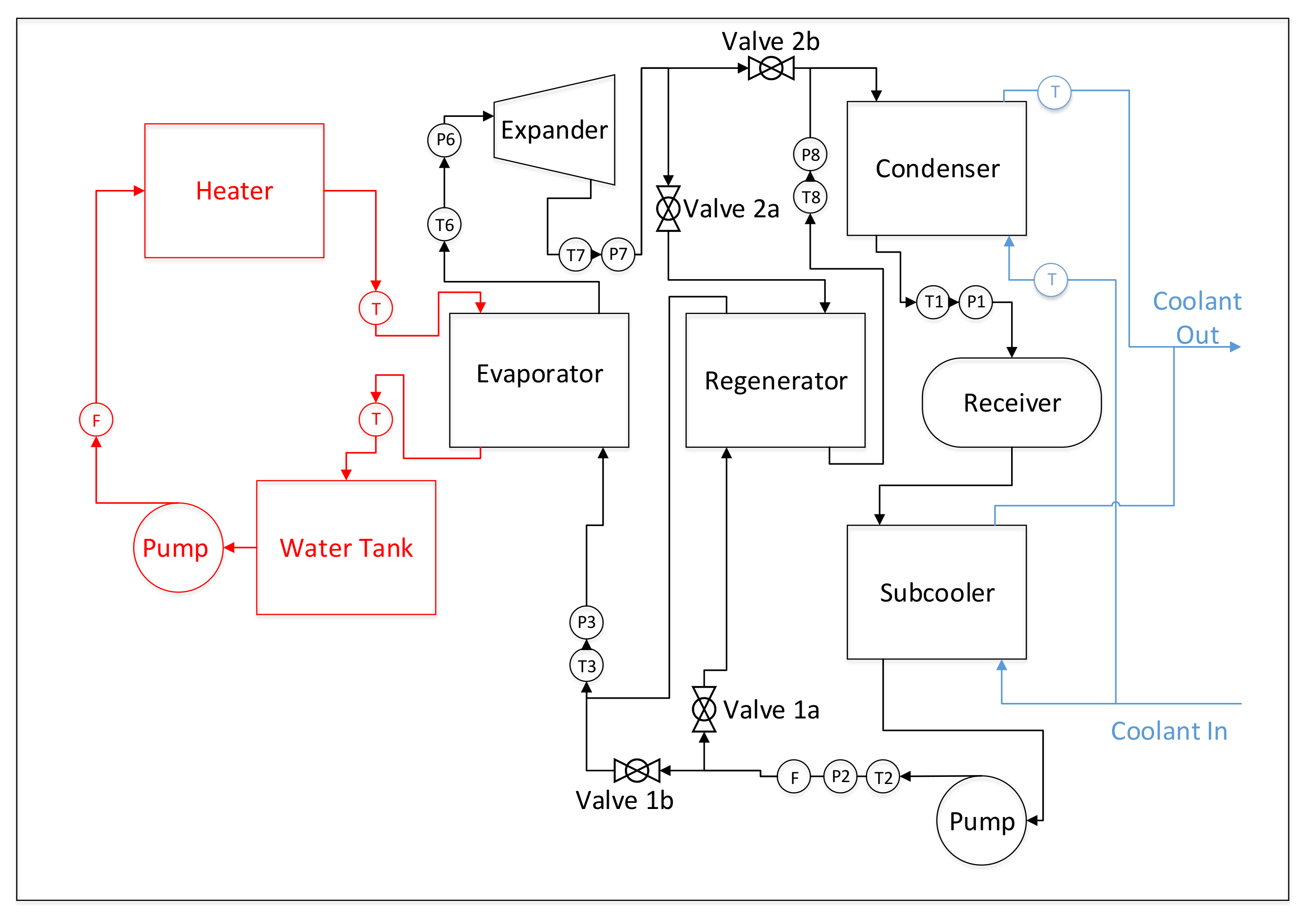


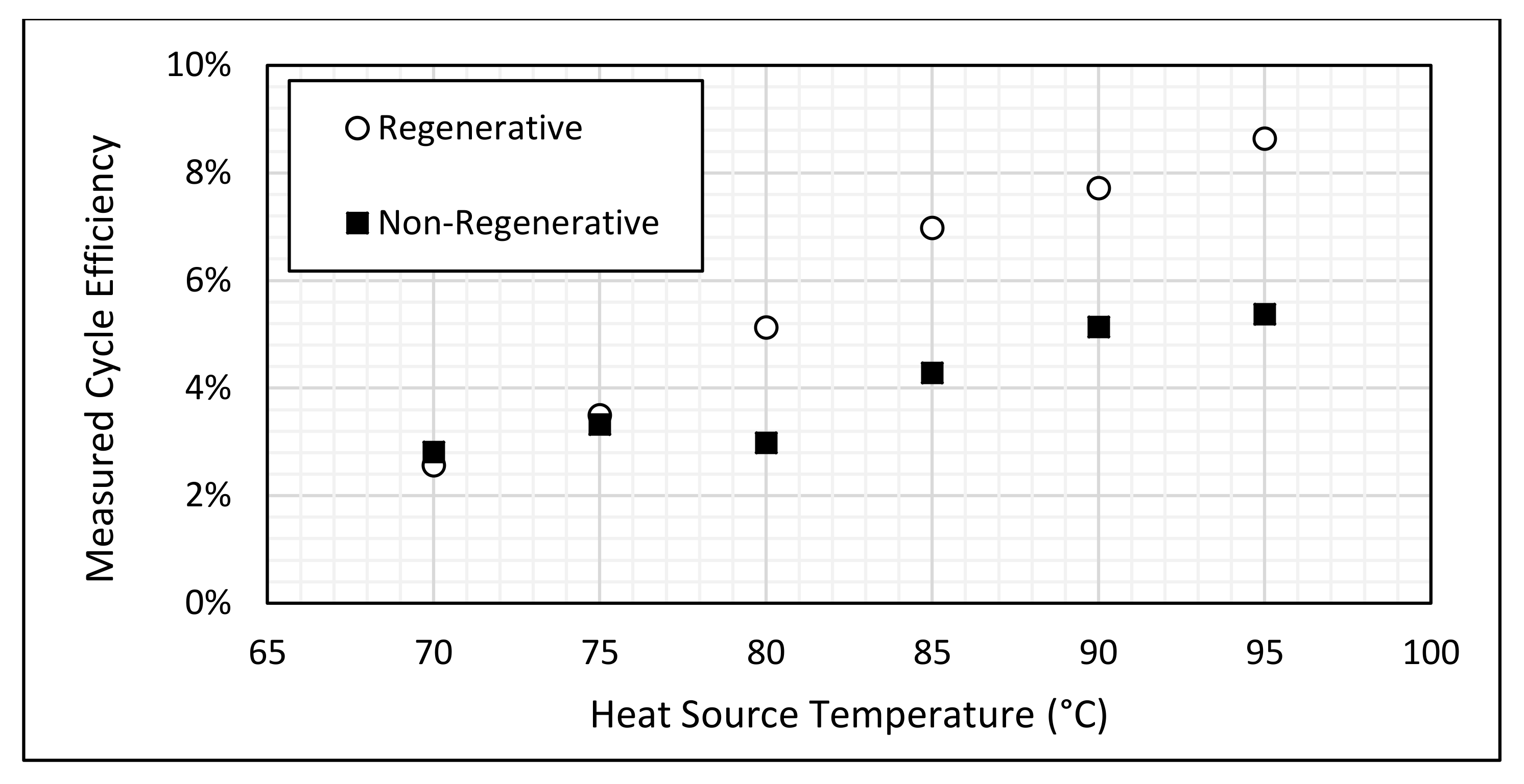
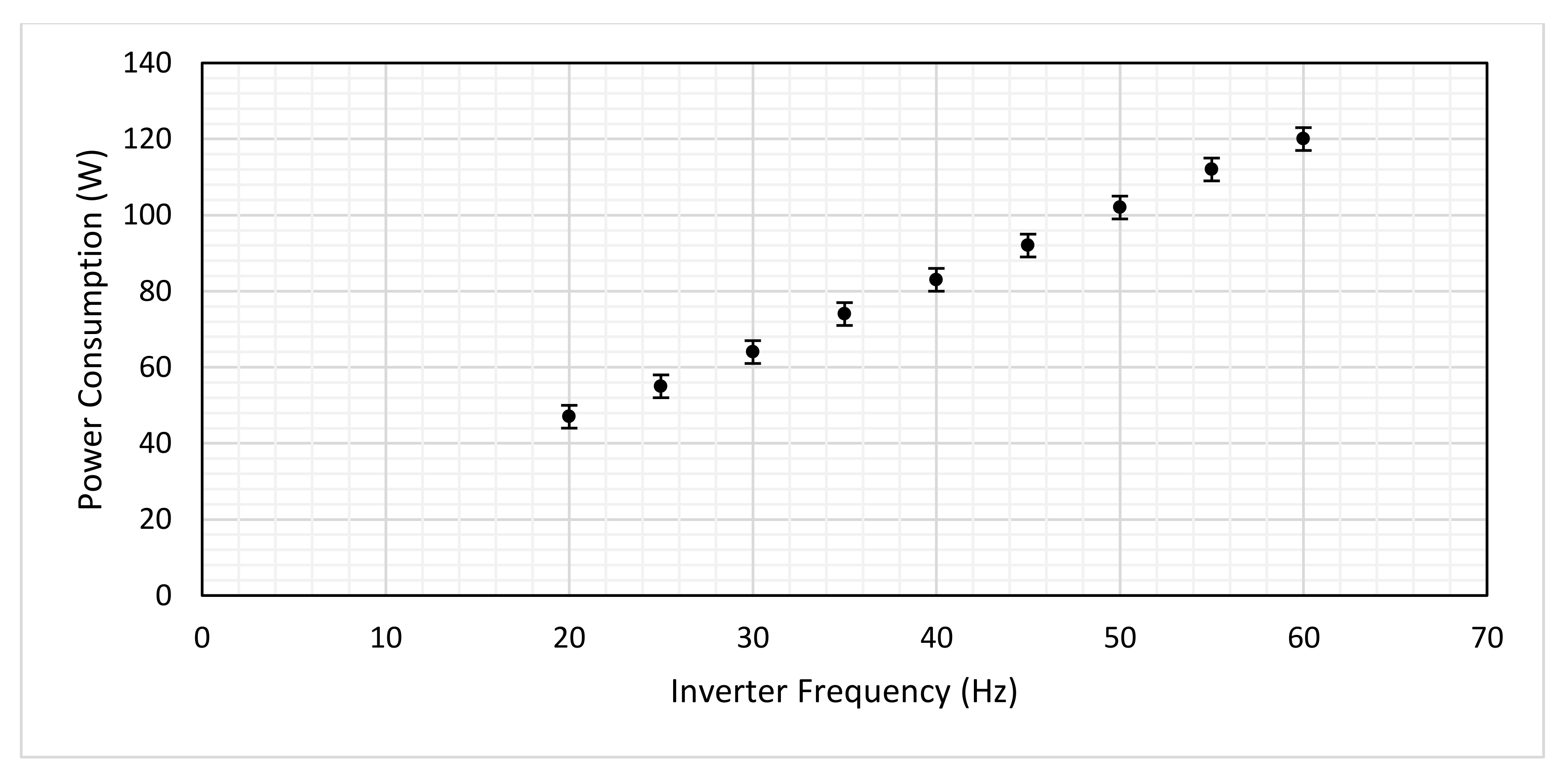

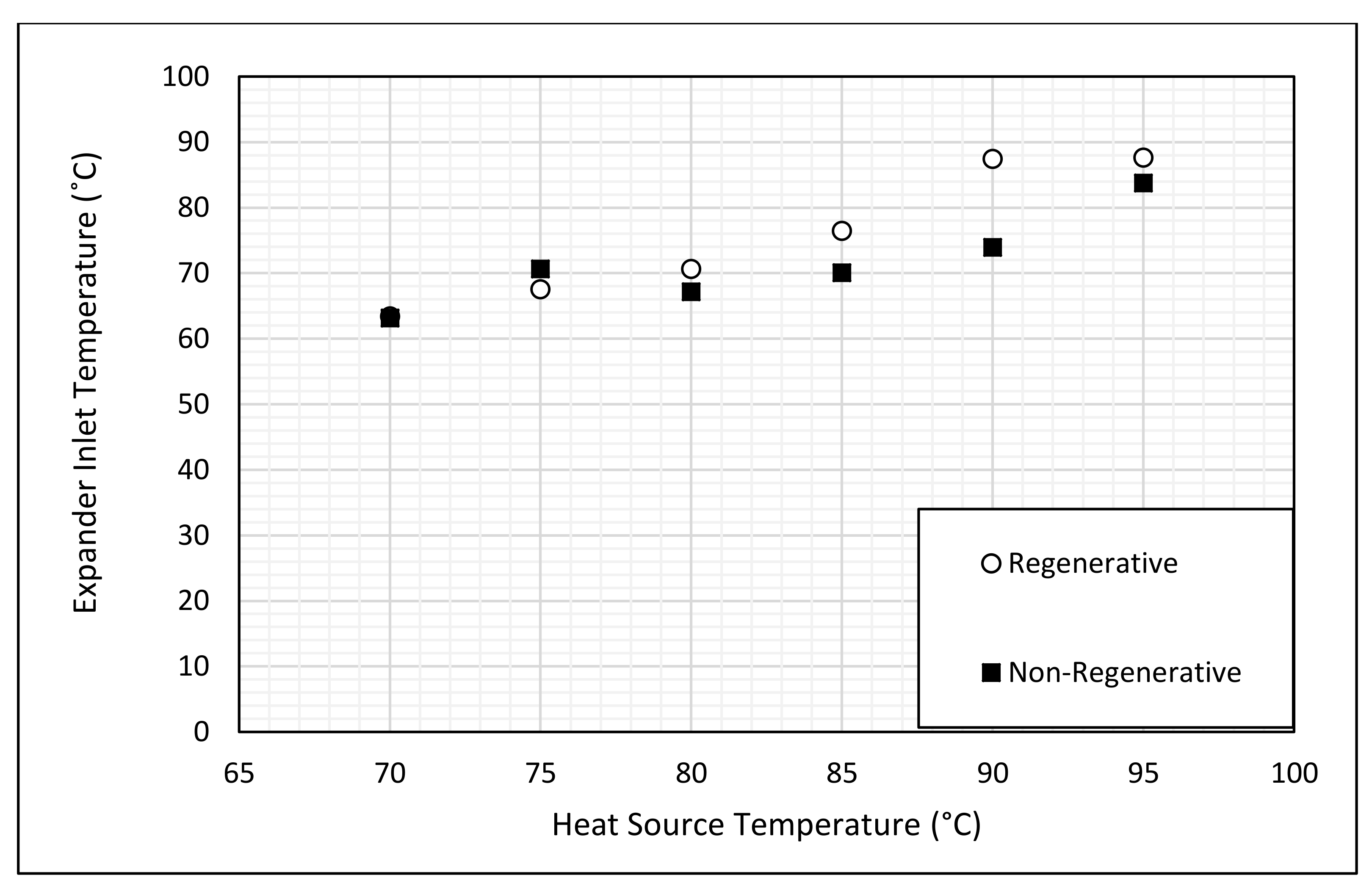
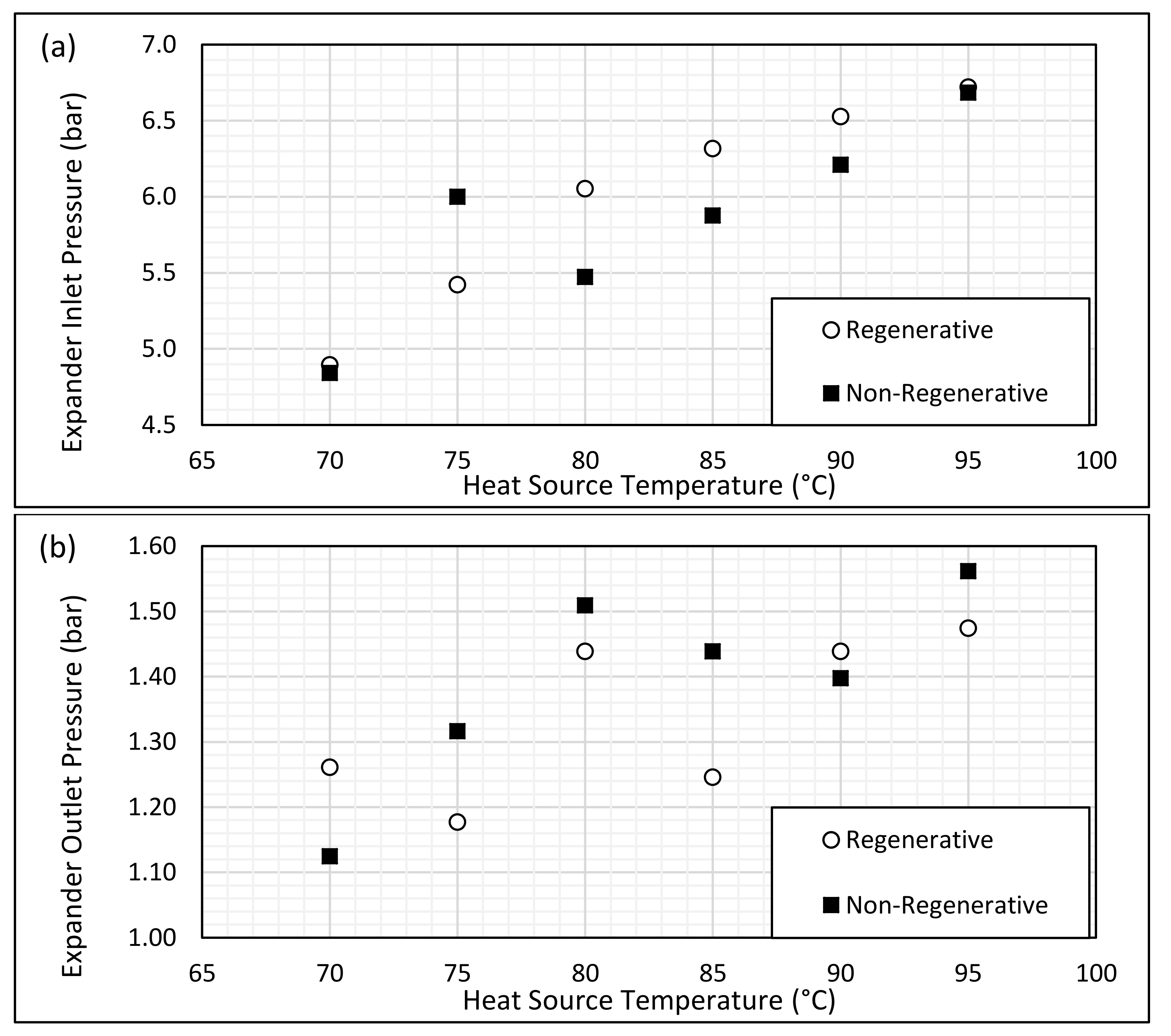
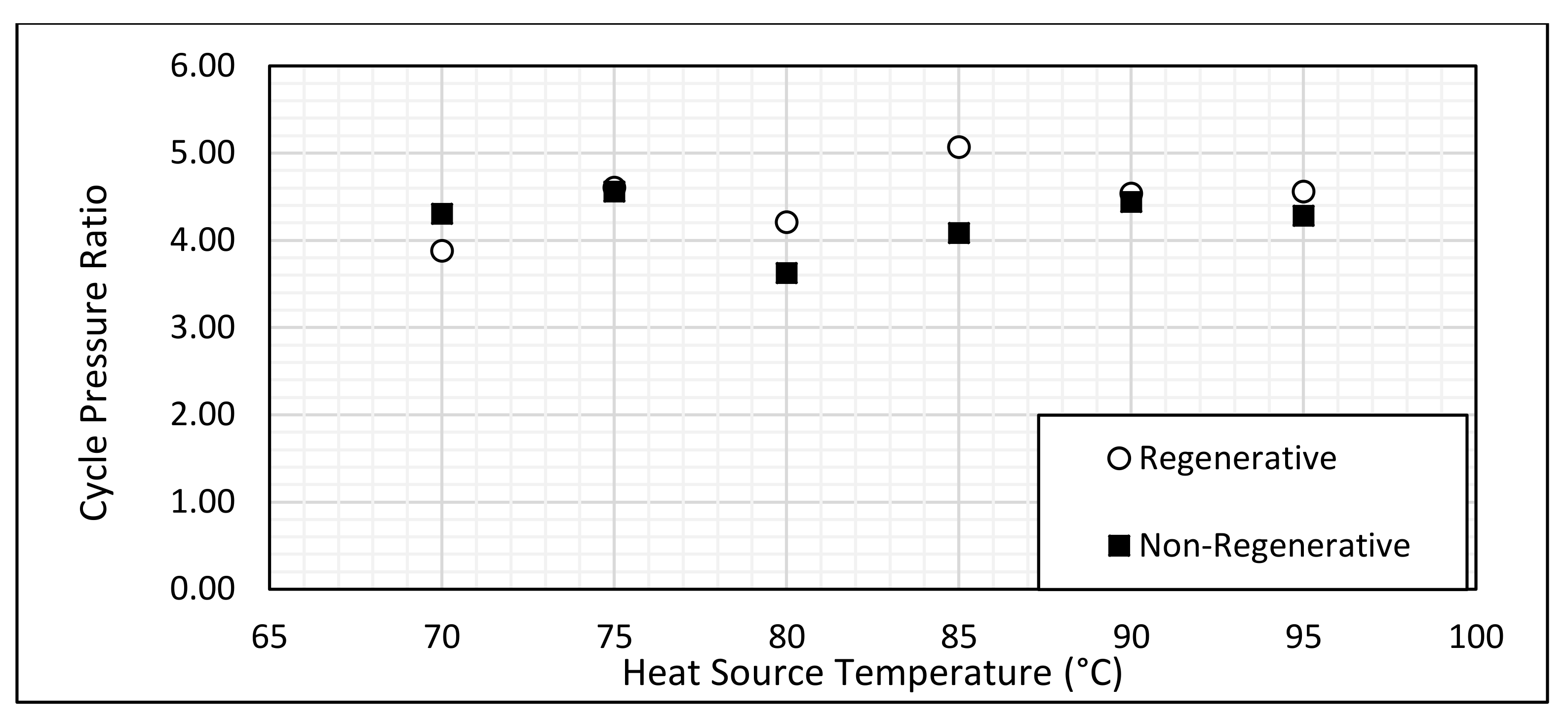
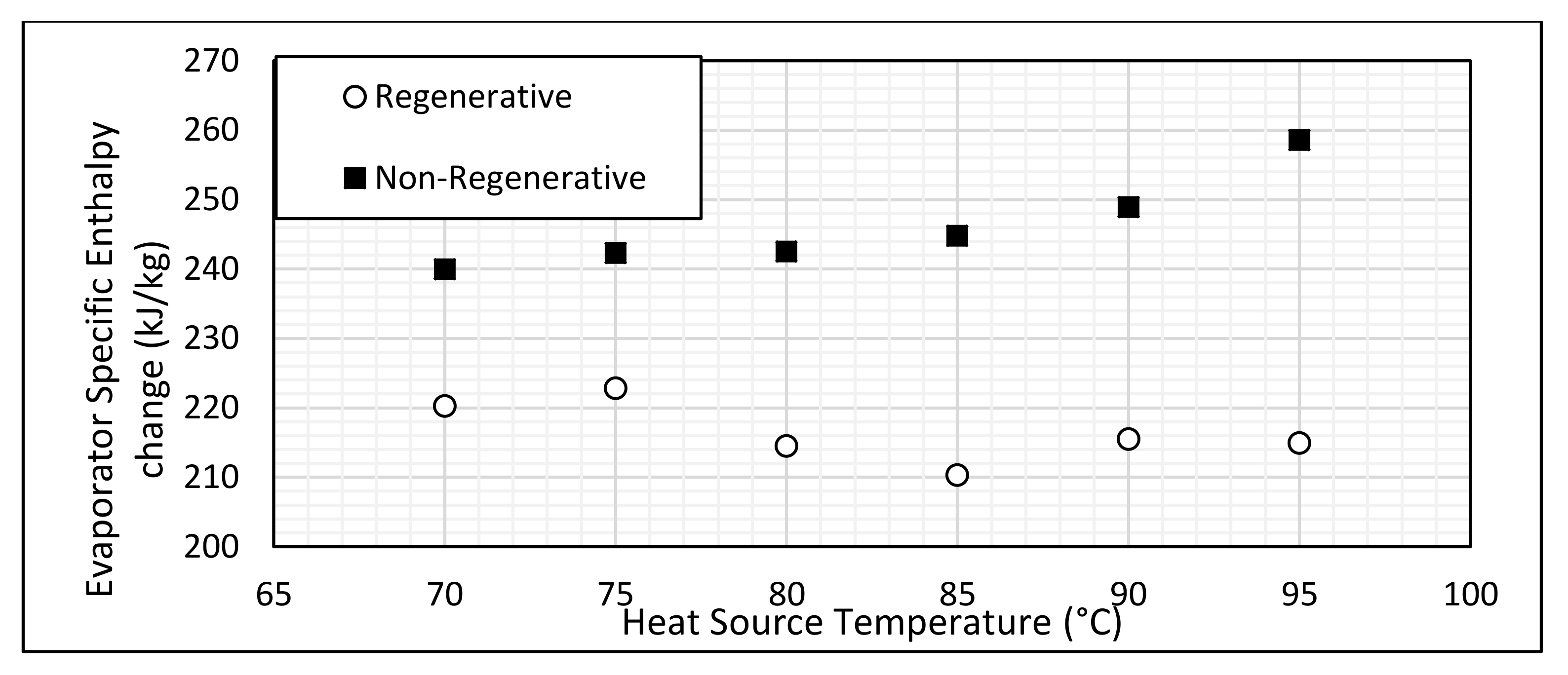
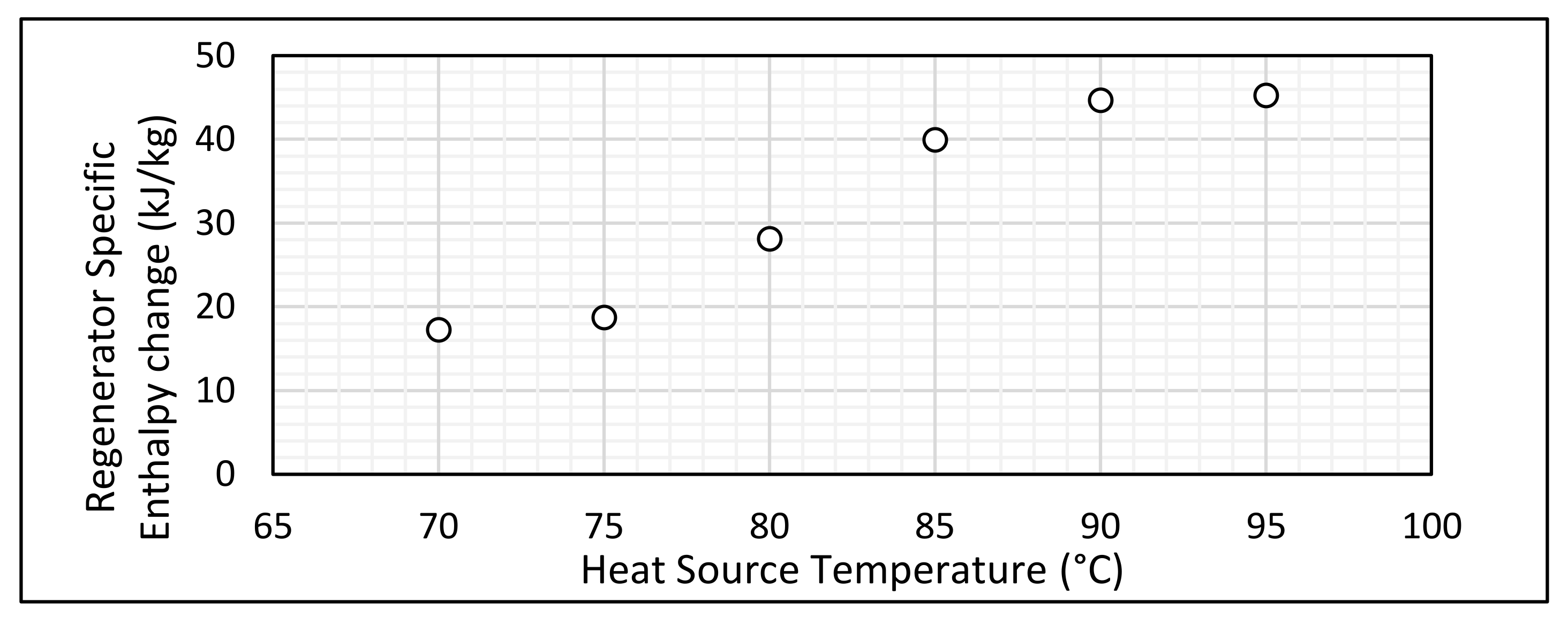

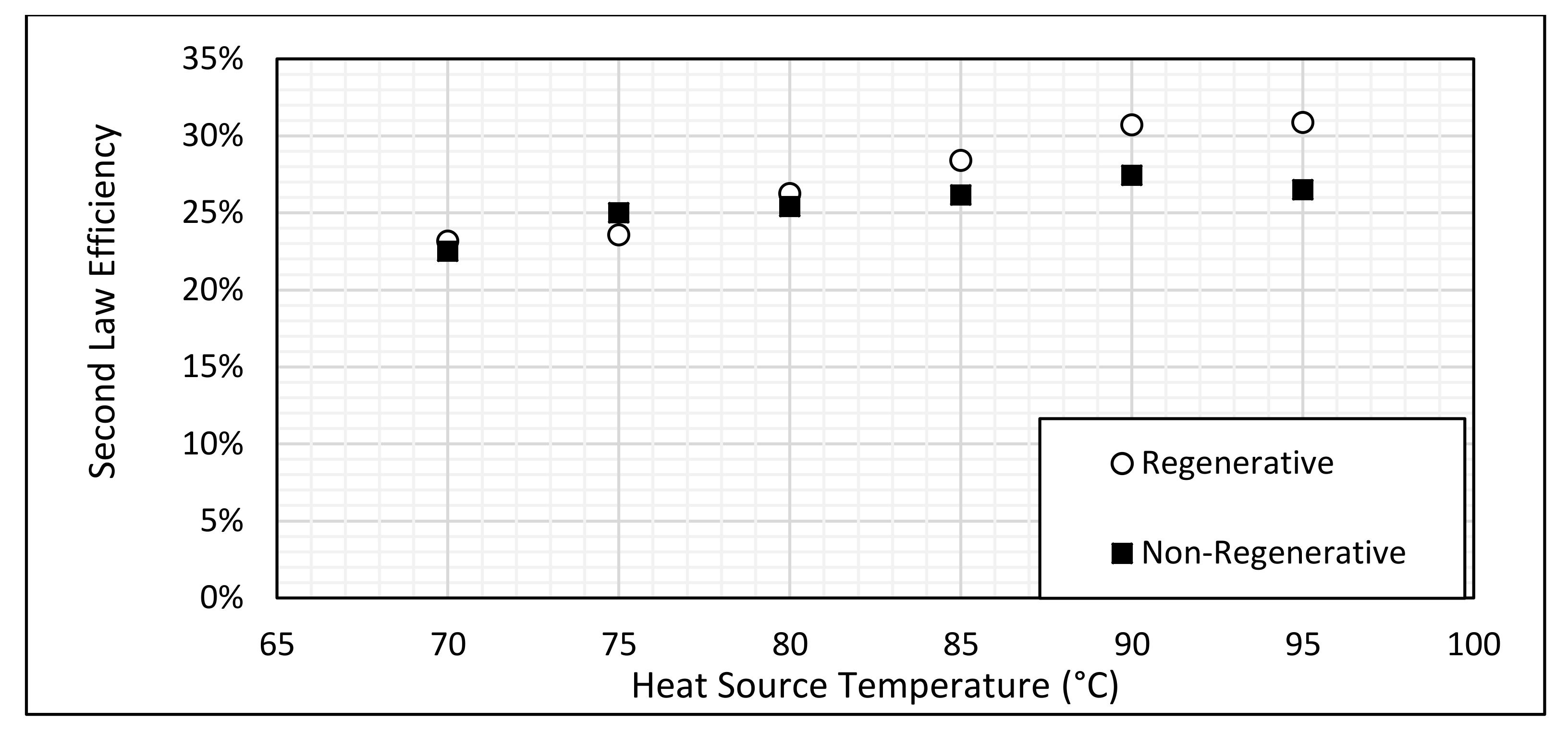

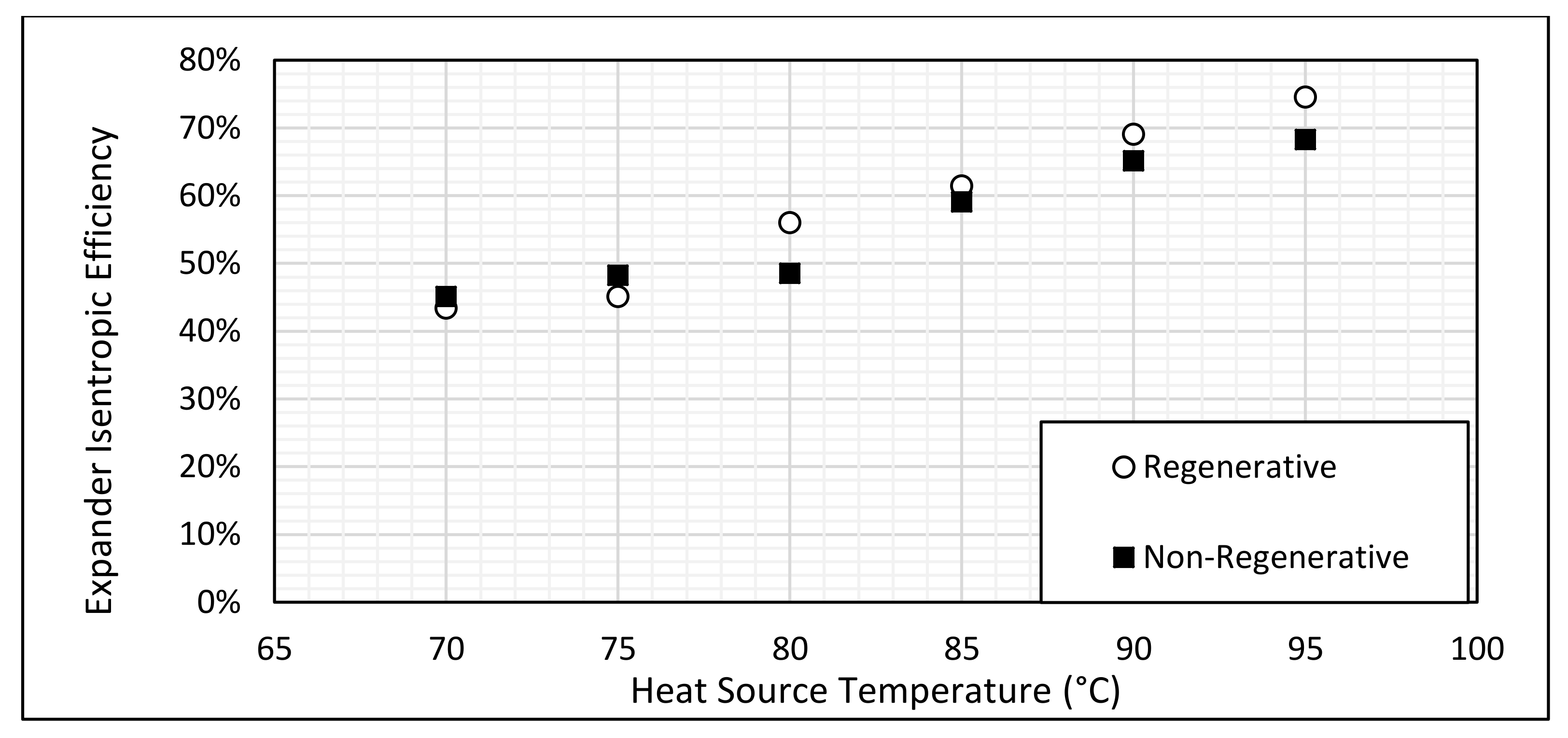
| Manufacturer | Airsquared |
|---|---|
| Type | Scroll, semi-hermetic |
| Nominal Output | 1 kWe |
| Volume Ratio | 3.5 |
| Displacement | 14.5 cm3/rev |
| Max Speed | 3600 RPM |
| Max Inlet Pressure | 13.8 bar |
| Max Inlet Temperature | 175 °C |
| Manufacturer | Hydra-Cell |
|---|---|
| Type | Diaphragm |
| Diaphragm Material | PTFE |
| Head Material | Polypropylene |
| Max flow rate | 3.8 L/min |
| Max Pressure | 24 bar |
| Motor | Single-phase AC, inverter driven |
| Manufacturer | Sondex Ltd. |
|---|---|
| Type | Brazed Plate |
| Material | Copper |
| Number of plates | 30 |
| Plate Area | 0.021 m2 |
| Total Heat Transfer Area | 1.26 m2 |
| Channel Thickness | 1.9 mm |
| Plate Thickness | 0.4 mm |
| Max Rated Temperature | 185 °C |
| Max Rated Pressure | 25 bar |
| Parameter | Experimental | Calculation | Units |
|---|---|---|---|
| Heat source temperature | 90 ± 0.2 | 90 | °C |
| Heat sink temperature | 7 | 7 | °C |
| Generator power output | 352 | 315 | W |
| Pump power input | 90 | 16 | W |
| Net power | 262 | 299 | W |
| Isentropic efficiency of expander | 74 | 70 | % |
| Heat absorbed by working fluid in evaporator | 3617 | 3660 | W |
| Heat reduction of the thermal fluid in evaporator | 3832 | 3660 | W |
| Cycle efficiency | 6.8 | 8.2 | % |
| Evaporator pressure | 5.82 ± 0.015 | 5.82 | Bar |
| Condenser pressure | 1.4 ± 0.0035 | 1.4 | Bar |
| Cycle pressure ratio | 4.136–4.175 | 4.16 |
© 2019 by the authors. Licensee MDPI, Basel, Switzerland. This article is an open access article distributed under the terms and conditions of the Creative Commons Attribution (CC BY) license (http://creativecommons.org/licenses/by/4.0/).
Share and Cite
Collings, P.; Mckeown, A.; Wang, E.; Yu, Z. Experimental Investigation of a Small-Scale ORC Power Plant Using a Positive Displacement Expander with and without a Regenerator. Energies 2019, 12, 1452. https://doi.org/10.3390/en12081452
Collings P, Mckeown A, Wang E, Yu Z. Experimental Investigation of a Small-Scale ORC Power Plant Using a Positive Displacement Expander with and without a Regenerator. Energies. 2019; 12(8):1452. https://doi.org/10.3390/en12081452
Chicago/Turabian StyleCollings, Peter, Andrew Mckeown, Enhua Wang, and Zhibin Yu. 2019. "Experimental Investigation of a Small-Scale ORC Power Plant Using a Positive Displacement Expander with and without a Regenerator" Energies 12, no. 8: 1452. https://doi.org/10.3390/en12081452
APA StyleCollings, P., Mckeown, A., Wang, E., & Yu, Z. (2019). Experimental Investigation of a Small-Scale ORC Power Plant Using a Positive Displacement Expander with and without a Regenerator. Energies, 12(8), 1452. https://doi.org/10.3390/en12081452






